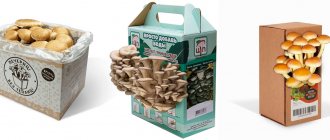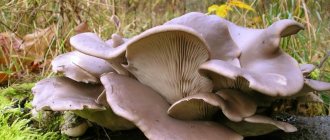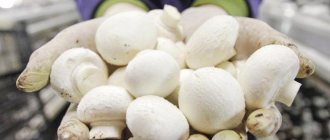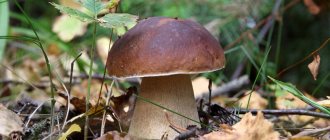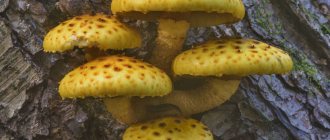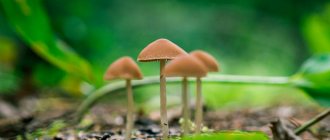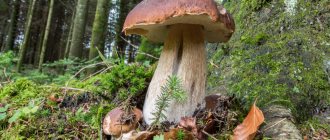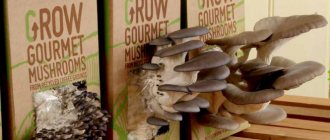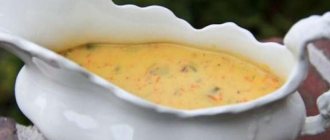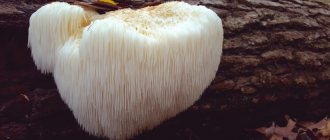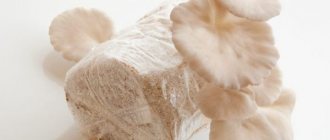Mushrooms are loved for the taste and incredible aroma they add to dishes. They can be salted, dried, pickled, fried, baked and frozen. This unique gift from nature has a lot of beneficial nutritional and medicinal properties. True, for seven praises, there is still one remark. Mushrooms are a seasonal product, and the mushroom calendar is quite capricious. One year we are literally covered with a mushroom invasion, the next the forest is greeted with a meager harvest.
If you love mushrooms as much as I do, then maybe it’s time to take the next step and grow your own edible mushrooms, for example, in the kitchen or insulated loggia? Yes, yes, you read that right! Growing edible mushrooms at home is no longer something out of the ordinary. Today, anyone can purchase a mushroom box with mycelium and harvest mushrooms within a week or a month, without leaving home.
"Silent hunt" at home
Mushroom boxes: 1 - champignons, 2 - oyster mushrooms, 3 - honey mushrooms
So, let's talk about “homemade” mushrooms? First, decide on the type of edible mushroom you would like to grow. Modern manufacturers of mycelium boxes delight you with a variety, so it will not be difficult for you to choose the right option for yourself, these could be:
- chanterelles and saffron milk caps;
- multi-colored oyster mushrooms;
- honey mushrooms and boletus;
- porcini mushrooms and boletus mushrooms;
- Champignon.
In addition, mycelium boxes are a great opportunity to find some new taste for yourself, experiment, diversify your dishes with the pungent aroma or bright color of fresh mushrooms.
It is better to buy a set of mushrooms not at garden centers, but to order them from specialized websites and mushroom farms. Often the mushroom boxes in the malls are not viable and the mushroom kit dies before you even buy it. You understand that you should not expect results from such a purchase.
The growing box consists of a growing medium (often sterilized manure or coffee grounds) and a grafting medium, usually something like peat, wheat bran, coconut fiber or sawdust with the fertile mycelium of your chosen mushrooms, a spray bottle for dosed watering.
Instructions for the mushroom farm
Oyster mushrooms prefer to grow on straw, compost is preferable for champignons, shiitake mushrooms love wood and sawdust, honey mushrooms love cotton waste and wheat or rice bran.
The box with the substrate has been treated, so the risk of infection by pathogenic mold or pathogenic fungi is minimized.
Since the mycelium already lives in the pre-mixed mixture, mushrooms grow much faster than those grown from spores.
Planting mycelium
After heat treatment of artificial soil for oyster mushrooms, it is necessary to quickly inoculate the mycelium. The ideal substrate temperature for planting is 21-29 degrees, humidity is 65-80 percent. If there are deviations from the presented indicators, there is a high probability of death of the mushroom rhizome.
The process consists of several stages:
- A day before planting, the mycelium is removed from the chamber and placed in an environment at room temperature. It is important that at the time of inoculation the temperature of the mycelium and substrate are the same.
- The planting material itself is poured into a sterile container and then crushed by hand. The specialist responsible for the process is required to wear medical gloves, and also disinfect his hands throughout the work. To do this, stock up on sodium hypochlorate solution.
- After the mycelium is crushed, it is immediately mixed with the substrate. You can cover the mycelium in layers or evenly. The total mass in relation to the soil is 4-5 percent to 100.
It is noteworthy that some plantations use non-standard methods for forming mushroom “beds”; for example, the total planting mass may have the shape of walls. For this, formwork familiar to builders is used. Foreign colleagues increase productivity by reducing the thickness of the substrate.
Conditions for the mushroom box
Although any mushroom farm you order comes with instructions, it doesn't hurt to have a little extra knowledge regarding growing conditions and general care.
Place
Beginning of mushroom emergence
Choose a location that is relatively warm with indirect sunlight and out of reach of children and pets. With the compact size of the boxes, finding it won't be too difficult.
Temperature
The ideal room temperature at the time of incubation of the mycelium, when it cultivates the substrate, is usually from 20 to 23 C. Humidity during this period should be increased, in the range of 70-85%.
The temperature should remain stable throughout the subsequent growing period, without large fluctuations. Otherwise, steam condensation on the fruiting bodies will lead to a bacterial infection.
Keep in mind that mushrooms will grow very slowly or may not appear at all in places where the temperature is constantly below 16 C, and conversely, as soon as the mushrooms begin to actively grow, move them to cooler conditions, such as an insulated balcony.
Different strains of mushrooms require different temperatures to bear fruit. Some mushrooms grow up to 12 C, while others require higher temperatures.
Spray bottle to create humidity
Humidity
Mushrooms that grow in the forest love damp places. They do not lose their preferences even at home. Humidity during cultivation should be increased, at least 70%. Daily spraying and water containers located near the mycelium will come in handy.
Lighting
Most mushrooms do not need a lot of light and therefore it is advisable to grow them in a dark place where there is a limited light source, for example, for growing in a basement, 8 hours of illumination from one light bulb will be enough.
Ventilation
Growing mushrooms need air circulation, but without drafts and wind, so for amateur cultivation, regular room ventilation a couple of times a day is enough.
Mushroom box harvest
Criticism
If growing mushrooms at home is so easy, why doesn’t everyone do it? It really does sound very profitable: in theory, for 150 rubles a month you can get a harvest of mushrooms for yourself or for sale. However, in practice everything is not so good. Some experts claim that cardboard boxes with mycelium are a scam and a way to get a thousand percent profit from a jar of soil. They make some compelling arguments.
Firstly, only champignons or oyster mushrooms are grown in industrial conditions. Other varieties, for example, white or truffles, despite their high cost, have never been grown on an industrial scale. Mushrooms grow in specially equipped rooms in bags. If truffles could be grown at home in a box by anyone, it is unlikely that they would be considered so rare and expensive.
Secondly, most mushrooms grow in symbiosis with trees. For example, porcini mushrooms need pine, spruce and birch trees. Chanterelles, saffron milk caps and boletus grow together with pines, larches and Siberian cedars. It is impossible to recreate such conditions in a cardboard box.
Unfortunately, many people do not have theoretical knowledge about mushrooms. They do not fully understand what these organisms are and why they are separated into a separate kingdom. They combine the properties of animals and plants, and are also not fully understood. Scientists cannot answer all the questions about mushrooms; they remain a very mysterious phenomenon. Some species are symbionts: they develop only together with another organism, using its resources.
These provisions give significant reasons to doubt the possibility of harvesting mushrooms from a cardboard box.
Growing oyster mushrooms
One of the easiest, fastest growing and most inexpensive options is growing oyster mushrooms. These are great as a trial for new mushroom lovers and as a unique gift.
All you need to do is tear off the front of the box, cut or cut the film covering the mushroom seed substrate and let the base soak in water. After that, you simply put the box in a suitable place: shady and warm, try to maintain the temperature within 22 C. Do not forget to spray the “window” 2-3 times a day to maintain a moderately humid environment in it.
Additionally, create a microclimate. To do this, soak a canvas napkin in water, wring it out, place a container of water in front of the “window” and cover the box with the mycelium so that one end of the fabric is dipped into the water.
As soon as the first mushrooms appear, for their further forcing, move the box to a cooler place, with a temperature of 12-14 C. This is all that is needed for the growth of future mushrooms.
After you harvest your first crop, the base should be removed from the box, soaked in water for several hours (12 to 18), then removed, drained, and placed back in the box. Create a microclimate and do not stop spraying daily. Soon the mycelium will delight you with another portion of mushrooms. And so on until its service life expires.
order a mushroom farm with oyster mushrooms on the official website of the manufacturer.
Oyster mushrooms need intense lighting, at least 12 hours a day. It is better to illuminate mushrooms with fluorescent lamps; if you grow them in a cellar or basement, one lamp will be enough. Similar growing conditions are suitable for bright red chanterelle beauties.
Lack of light will affect the fruiting bodies, namely, too small caps and long legs.
Real customer reviews
Love. We received it, sat down and waited. It's finished! The husband rejoices like a child. Even the cat came to watch. Let them grow up, then we’ll eat them. Good entertainment during self-isolation, the quarantine was not in vain! I recommend it, the mushrooms will please you. The reviews helped a lot. We acted according to instructions, but also used advice. Thank you!
Anna . It’s a very interesting thing to grow your own mushrooms! Everything worked out, the main thing is to follow the instructions. The mycelium grew steadily for 2 weeks and on the third week shoots appeared! We are waiting for them to grow bigger and try the yummy)
Margarita . I don't know what needs to be done to prevent them from growing. Apart from pouring boiling water on the soil and sprinkling alcohol on the spoon, there was no sterilization. She mixed it, put it in a bag and threw the bag under the table in the kitchen. There is no temperature or light control, the windows are wide open all the time, and it’s quite cold outside. The result is even a little unexpected, but I'm so happy!
Alexei . good mycelium! I used to buy it in another store, but there is no difference (except that it’s a little cheaper here). Mushrooms are growing. I recommend.
Box with honey mushrooms
The process for preparing a box of mushrooms is the same as for oyster mushrooms. After you prepare the box and moisten the base, provide the future mycelium with the proper conditions, namely:
- average temperature 10-15 C;
- daily ventilation of the room;
- additional illumination with fluorescent lamps with diffuse lighting, 5-6 hours;
- humidifying the air using: water in containers, wet rags or a spray.
At first, keep the box in a warm room, with a temperature of 23-26 C, as soon as the mycelium germinates, the temperature should be immediately reduced to 12 C. The mushrooms can be placed on a window sill on the north side of the house or an insulated loggia.
In summer, mushrooms must be kept in a cool room.
The harvest can be harvested 14 days after planting.
Remove the mushrooms from the substrate carefully, cutting them with one hand and holding them around the root with the other. Then clean the growing area by removing the remaining stems of dead mushrooms. Soak the base in water for several hours, place it in a box and wait for the next harvest. With proper care, it won't keep you waiting long. Similar conditions are suitable for growing butternut squash.
Do not forget that honey mushrooms, no matter how tasty they are, are fungal parasites that can grow on living and dead wood. Therefore, when growing them in a wooden house, be prepared for the fact that they will “run away” onto the walls.
Where to get planting material
Planting material can be purchased at the store. Usually the mycelium is sold separately, as well as a mushroom box with soil and mycelium. This simple method of growing mushrooms at home is great for beginners. The effectiveness of buying a box or set is that you don’t need to plant mushrooms, just water them and a harvest will appear. Growing takes place right inside the cardboard. Do not forget about choosing a place where it is better to keep this box, for example, on the balcony.
You can also make mycelium with your own hands. Simply grind the fruits in a meat grinder and dry the mixture. It can be planted in the ground.
You can grow mycelium with your own hands. We go to the forest for mycelium. The mushroom is dug up along with the root. It must be carried carefully so as not to damage it. Do not clean the soil from the mycelium; it is necessary for it to take root. For this method you do not need to spend money on buying mycelium, but the disadvantage is that growing it inside the house is impossible, only on the balcony or in the basement.
If you make compost yourself, you need the following ingredients:
- straw;
- limestone;
- seed husk.
All ingredients are crushed and boiled in water over low heat. To plant, the mixture must be cooled to 25°. Then mycelium is added to the soil. We water the soil generously.
Video on how to grow mushrooms at home:
Growing Shiitake Mushrooms
Some farms use a box that is pre-filled with growing medium inoculated with spores. Others come complete with hand-cut logs, pre-drilled holes that are filled with fungal spores or mycelium, and then coated with cheese wax to protect against insects and other natural predators.
Whichever option you choose, it is easy to clean and maintain. All you need to do is keep the mycelium base moist and at a relatively constant temperature throughout the growing cycle.
Germination of the mycelium takes about a month, at a temperature of 25 C and 80% humidity. Then, the sprouted mycelium is transferred to a room with diffused lighting and good ventilation. Recommended microclimate parameters are temperature 15-20 C, humidity not less than 85%.
The harvest is formed in stages; each batch of mushrooms must be carefully cut off at the very base of the stem.
If you are not a stranger to experiments, try growing more exotic mushrooms than classic champignons and oyster mushrooms.
Harvest and storage
The fruiting period of oyster mushrooms is 6-7 days from the moment the buds appear from the upper layers of the substrate. This time is enough for the small embryos to transform into ripe, edible fruiting bodies. The culture develops in so-called clumps, each of which consists of already mature and still young mushrooms.
When picking, it is customary to twist all the fruits at the same time - there is no point in waiting until the babies reach large sizes, since already mature representatives will begin to deteriorate. If you leave tiny mushrooms on the clump, collecting only the large ones, their growth will stop due to damage to the “base”.
As we noted earlier, oyster mushrooms can bear fruit in several waves, but only the first two can be considered productive. The first stream of ripening brings the agronomist approximately 65-70 percent of the harvest, the second - 20-25. There is no point in waiting for the third one; its percentage does not exceed 10 units.
From the above we can conclude that one technological cycle in production lasts no longer than 2.5 months. Ripe mushrooms are carefully cut from the soil, freed from debris, and then placed in boxes/boxes/baskets. To ensure that the product does not lose its presentation, it is necessary to minimize the number of movements of mushroom fruits from container to container.
To preserve the weight of oyster mushrooms, avoiding the natural drying process, polyethylene is used. The harvest is wrapped in film and transported to the place of sale.
As for storing fresh mushrooms, its period should not exceed 6-7 days at an air temperature of no higher than 6 degrees Celsius. If the room is hot, the product will spoil within 24 hours. The exception is freezers, in which the shelf life increases to 1.5 - 2 months.
Every agronomist who grows oyster mushrooms for sale must follow the written standards. A quality product is distinguished by the following indicators:
- The body of the mushroom should have a pleasant smell, dense pulp and clean skin.
- The optimal size of the fruit cap of the 1st grade is from 5 to 12 centimeters, the legs – up to 10.
It is strictly forbidden to distribute or consume damaged, watery, loose or musty fruit bodies.
Lifehack! If you do not have your own premises, you can read the article - Growing oyster mushrooms on stumps on the site.
Reasons why mushrooms may not grow
While many factors can affect successful mushroom growing, there are some common mistakes that can be easily avoided. If you are just learning to grow mushrooms, then this knowledge will be useful to you.
Lack of moisture
Mycelium needs a moist environment to thrive and produce mushrooms. Mushrooms themselves are essentially water, so if you allow the mycelium to dry out or the air humidity becomes too low, the mushrooms will either slow down or not grow at all. For effective mushroom growth, control the humidity level in the area where your mushroom boxes are located.
Excess moisture
Too much moisture, on the other hand, can lead to a damp box, mold and standing water, which will negatively impact the health of the mycelium. If the mixture looks like it is starting to dry out, spray it lightly.
An air humidifier will help you create comfortable conditions in the room where mushrooms grow. By creating a fog effect, you can control the development of mushrooms and their yield, prevent waterlogging, the development of mold and disease.
Air exchange
Although mushrooms do not need a lot of fresh air, they do need a well-ventilated area without strong air currents or air movement (not near an open window). Lack of air exchange will cause the level of carbon dioxide to begin to accumulate and affect the development of fruiting mushroom bodies.
- the shape of the mushrooms is distorted, namely, the legs lengthen, and the diameter of the caps, on the contrary, decreases, or there are no caps at all;
- the caps may acquire a burdock-like shape with raised edges;
- the height of the fruiting body increases 5-6 times;
- the fruiting body becomes fragile;
- productivity decreases.
To ensure access of oxygen to the mycelium, ventilate the room in which your mushroom boxes are located several times a day, 3-4 times.
Low level of production
One of the fundamental reasons for the failure of mushroom boxes is non-viable mycelium.
To avoid this problem, buy mushroom farms only from trusted manufacturers, focusing on product reviews on specialized forums.
When receiving goods by mail or through a courier, pay attention to the expiration dates of the mycelium.
Variety of mushroom farms
Preparing the base for the substrate
The most used raw material for mushroom substrate is cereal straw.
Dry stems are best suited for successful fermentation, and even though some farmers prefer tops of garden crops, sawdust, etc. to straw, we will look at how to prepare the substrate on straw, since even capricious champignons grow in it. The main condition is that the raw materials must be of high quality, fresh, dry enough, and without signs of mold. Good straw has an even golden color and a pleasant smell.
Basic manipulations when preparing the “base” ingredient:
- Grinding dry plants.
- Soaking in water.
It is important that the straws are the same size, preferably short, about 5-10 centimeters. Experienced mushroom growers explain the requirement by saying that small fragments of hay are easier to process. In addition, there will be fewer “gaps” in the substrate that prevent the mycelium from developing.
After the raw material is crushed, it must be soaked. The hay is placed in large containers and filled with clean water without impurities. The future substrate must absorb moisture; excess liquid is squeezed out afterwards. In industrial-scale production, special belts are installed, with the help of which hay is passed between two rollers. Everyone remembers Soviet washing machines and their spin principle - this system works identically. Alternative methods are using a jack or workers' hands. The goal is to achieve optimal humidity (no less than 60 and no more than 70 percent).
Since not every mushroom grower has special equipment, checking the humidity level can be done manually. To do this, you need to take a little substrate in your hand and squeeze it. If water is squeezed out and dripping from the stems, there is a lot of liquid. It is ideal when droplets emerge from the raw material, but do not spill onto the floor.
It is important to ensure that the straw is not in water for more than a few hours, because in this way the raw material is not only saturated with moisture and cleansed of pests, but also loses useful microelements and nutrients.
Should you grow mushrooms at home?
If you really love them, then why not.
- boxes of homemade mushrooms can be a great hobby for everyone in the family, and growing small quantities in a controlled environment will not be burdensome;
- you will receive a nutritious product with high energy and dietary value for relatively little money;
- the mycelium box is easy to maintain, and you fully control the growing process from “A” to “Z”, without much difficulty;
- mushrooms grown by yourself are of high quality;
- You can grow mushrooms all year round;
- mushroom boxes are ready for use immediately after purchase without prior preparation;
- guaranteed harvest in 2-3 weeks.
Rules of courtship
The advantage of this method of cultivation, according to manufacturers, is ease of care: you only need to water the mycelium with water 2-3 times a day. Any beginner can cope with this task, which means that anyone can grow mushrooms at home, even without special training and knowledge.
No additional fertilizer is required: it is assumed that everything you need is already in the box. Special climatic conditions, for example, dampness or a certain temperature, are also not needed.
Best Mushroom Farm Kits
The best producers 1 - Homemade mycelium "Oyster mushrooms".
2- Mushroom kits from Tatgrib for growing champignons and oyster mushrooms. 3 — “Mushroom farm” kits using Canadian technology. If you are new to this business, then when buying your first mycelium box, try to rely on reviews. For example, more than half of the reviews report good results, and satisfied customers share photos of their mushroom harvests, then I think this manufacturer's product is good and definitely worth trying.
How to complete the technological cycle by preparing the room for growing a new batch
After the harvest is completed, it is necessary to clean the plantation of the used substrate and disinfect the room - only then can a new substrate with mycelium be laid. Please note a number of recommended pest control measures:
- Remove unnecessary raw materials from racks or area.
- Get rid of any remaining substrate using a household vacuum cleaner.
- Treat the room with formaldehyde (by mixing liquid formaldehyde with bleach in enamel tanks). Containers with the mixture should be left open, closing the room with them for at least 36 hours.
- After several days, remove the tanks with the connection and thoroughly ventilate the room.
- Prepare a formaldehyde solution (200-250 grams per 10 liters of clean water). Repeat the treatment, followed by ventilation.
- Wash the shelving shelves with sodium hypochlorite (1%).
Check the plantation for insects or other pests. If none are found, you can lay a new batch of substrate.
We looked at how to grow oyster mushrooms at home, as well as in industrial conditions.
Keep in mind that the growing season of the crop is accompanied by the appearance of fungal spores in the air, which can be dangerous for people prone to allergic reactions. To avoid trouble, use respirators and cultivate only special strains of mushrooms.
- Author: Maria Sukhorukikh
Rate this article:
- 5
- 4
- 3
- 2
- 1
(1 vote, average: 5 out of 5)
Share with your friends!
Project contacts
The domain https://gribnica-doma.ru was registered on December 22, 2018. This template is also used by other sites that were registered earlier. The chain of similar clones has been going on since 2016.
The address of the company and its data, which are indicated on the project: LLC "Russian Mushroom Company" OGRN 1095031003473, INN/KPP 5031087096 / 503101001 142440, Moscow region, Noginsky district, Stulovo village, Shkolnaya street, 1
By the way, such an organization really exists. But she has nothing to do with these scammers. This company is a supplier of mushrooms to various chain stores. The scammers simply used the data.
Activity on the site began on February 2. More than 1,000 people visit it every day. There is active spam on social networks. Almost 50 percent of visits come from social networks.
